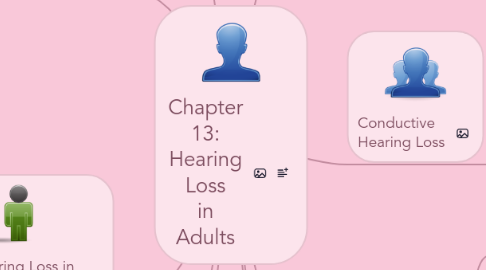Chapter 13: Hearing Loss in Adults
von Lindsey Green


1. Definitions
1.1. Recruitment- makes it difficult for a person with hearing loss to tolerate common loud sounds.
1.2. Tinnitus- a ringing, roaring, buzzing, or hissing sound in one or both ears.
1.3. Signal to noise ratio loss- hearing loss and loss of speech clarity due to inner hair cell damage.
2. Impact of Hearing Loss
2.1. Problems Reported
2.2. Depression
2.3. Anger and Frustration
2.4. Paranoia
2.5. Denial of the severity and extent of hearing-related problems
2.6. Feelings of loss of control
2.7. Pretending to understand others when they do not
2.8. Violating the rules of communication
3. Causes of Hearing Loss in Adults
3.1. Common Causes:
3.2. Head Trauma
3.3. Barotrauma
3.4. Tumor
3.5. Ototoxic Drugs
3.6. Infection/Disease
3.7. Illness
3.8. Noise exposure/damage
3.9. Aging
4. Assessment Tools
4.1. Observation and Self-Assessment
4.2. Conventional Audiometry
4.3. Objective Measurement
5. Amplification Devices
5.1. Hearing Aids
5.2. FM Systems
5.3. Assistive Listening Devices
5.4. Cochlear Implants
6. Sensorineural Hearing Loss
6.1. Characteristics
6.2. Results from damage to the outer or inner hair cells of the cochlea
6.3. Recruitment or tinnitus may be experienced as well
6.4. Causes
6.5. Presbycusis (Aging)
6.6. Noise Exposure
6.7. Ototoxicity
6.8. Meniere's Disease
6.9. Labyrinthitis
7. Conductive Hearing Loss
7.1. Causes
7.1.1. Cerumen Blockage (particularly due to the use of cotton swabs)
7.1.2. Otosclerosis- abnormal bone growth develops around the ossicles
